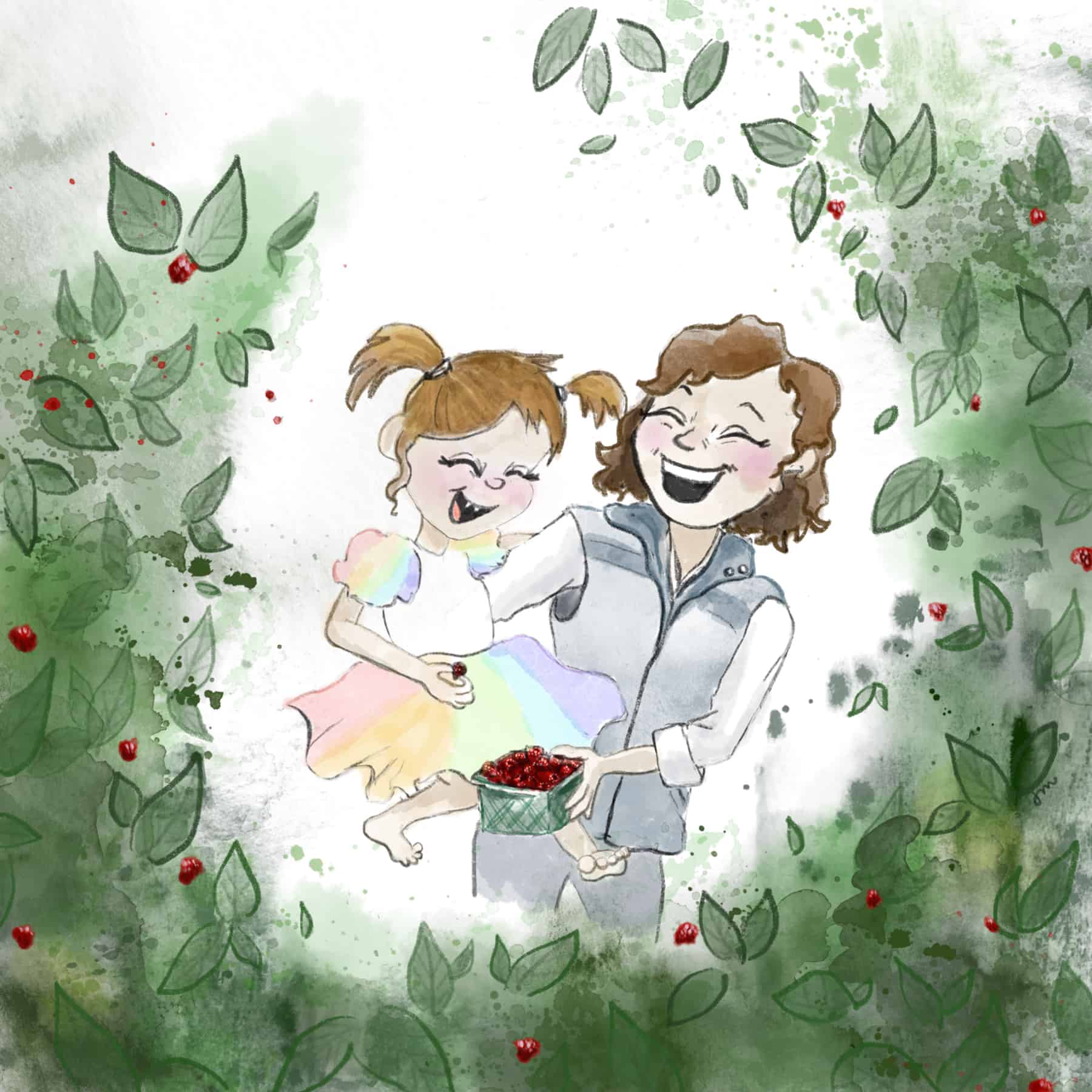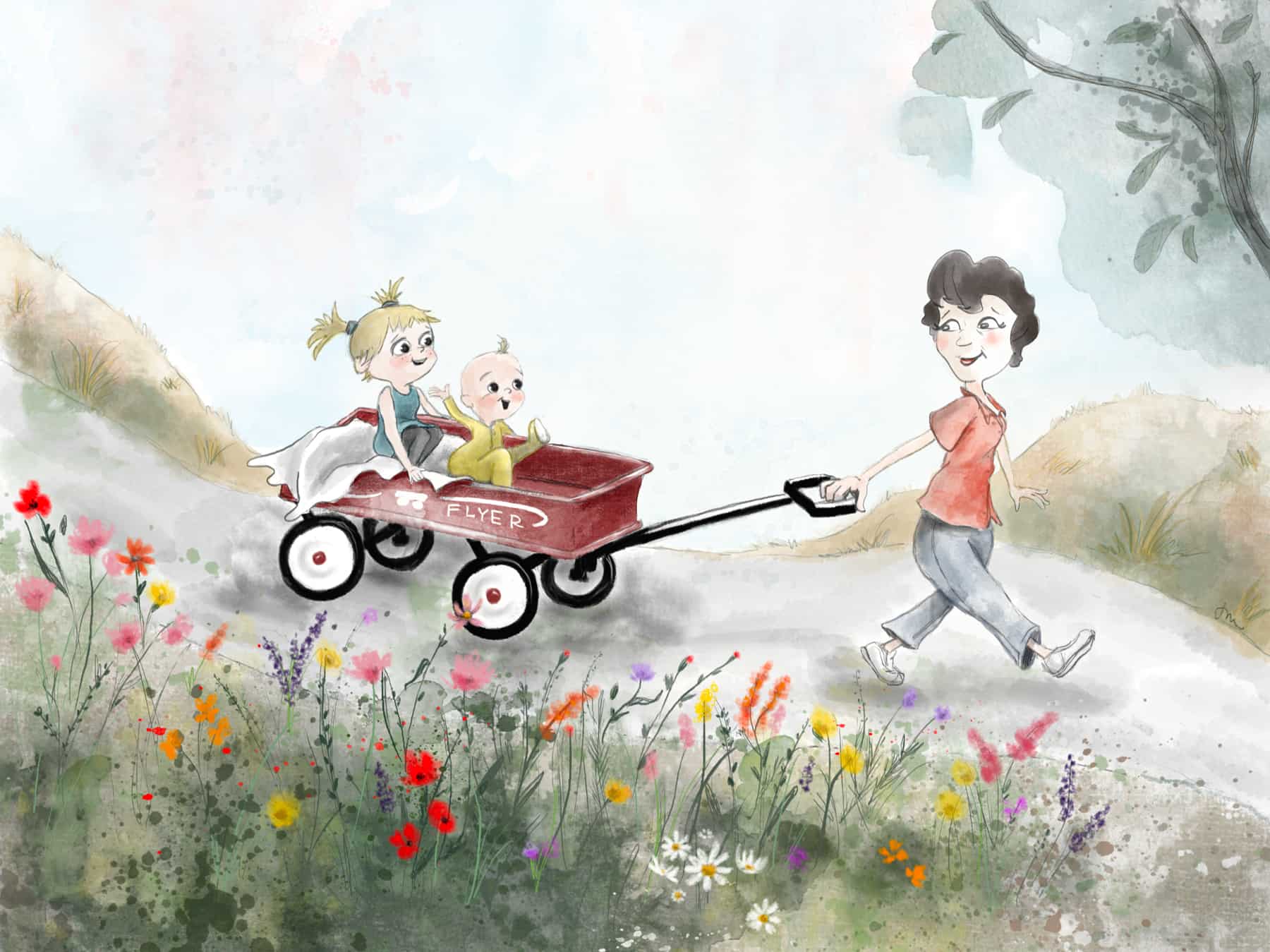By Kristine Kopperud // Illustrations by Julie Millard
—
On a sunny Monday morning, Megan LaTorre, of Victor, nabs a picnic table in the Driggs City Park, a large summery “mom tote” over her shoulder, and a to-go carrier of steaming Rise Coffee House pick-me-ups in hand. Her kids, four-year-old Teagan and seven-year-old Taggart, are already running in wide loops ahead of her, racing each other to the play equipment.
“Scheduling fail,” she says, grinning, as she settles in. She’d been planning for the kids to start two separate outdoor camps that morning, but having registered (many) months in advance, the exact start dates had slipped her (usually bullet-proof) calendar.
Megan’s mom, Betsy Curfman, slides in next to her on the picnic bench and waves off any inconvenience. She’s in full Grandma mode, with one ear tuned to intercept any kids’ bickering. She’s also wearing lace-up sneakers so she can hop up and respond when one child, or the other, has a new trick to show her on the jungle gym.
Together, mother and daughter are testing the “grandmother hypothesis,” a phenomenon coined by anthropologists in the late 1950s to explain an array of positive outcomes in cultures where young mothers traditionally lived close to their own mothers. (Grandfathers, we love you, too.) The proximity of “grandmothering” among the Hadza hunter-gatherers in Tanzania, for example, appeared to free up a young mother’s productive time and resources, which equated to greater prosperity and benefited her children’s health.
Anthropologist Kristen Hawkes, who has been studying Hadza culture since 1997, noticed a correlation between how well children grew and their mother’s foraging work, until the mother had a second child. Then, the existing child’s growth correlated with “grandmother’s work,” Hawkes told Smithsonian Magazine. “There were the data right in front of us.”
In eras when just being a kid carried high morbidity due to disease and environmental danger, the presence of grandma’s supervision also significantly increased the likelihood of a toddler’s survival to age five (by 30 percent, in one study of Finnish state records between 1731 and 1895). Finally, there’s evidence that taking “active responsibility” for grandchildren appears to keep a grandmother more active and stronger, positively impacting her health-span.

Megan and her husband, Brad, moved to the Teton region in 2012, settling first in Jackson before they built their home in Victor and their kids were born.
“We were living on ‘Microsoft Lane’ in metro Seattle and just knew it wasn’t the place we wanted our kids to know as ‘home,’” Megan explains.
An experienced marketing and project manager, she started applying to jobs in mountain towns, eventually taking a position with Parks and Recreation in Jackson. When her kids were little, Megan pieced together freelance work as a social media/brand manager to stay home with them. She’s now a multimedia sales manager across the many channels of Teton Media Works, and post-COVID, she’s returning to a commute to her Jackson office, after years of working exclusively from home.
Enter Grandma Betsy and (Megan’s dad) Grandpa Greg.
Having visited Jackson on and off when the kids came along, they’re now building a retirement home adjacent to Megan’s family—a long evolution in an adventurous history of investment. Since 2013, Betsy and Greg have owned and run a guest house in Nayarit, Mexico, during the winter, but now, the pull of the grandbabies has won. Together, both sets of parents are navigating the many benefits (and challenges) of living near each other for the first time since Megan left her childhood home in Kitsap County, Washington, for college.
“Parenting in your own house, with your own parents in your daily orbit is different,” Megan explains. “My dad, in particular, is famous for giving ‘advice,’ that isn’t quite how I’d put it,” she says with a chuckle. “As young as they are, my kids know not to repeat things as soon as they hear me say, ‘Oh, we don’t say that in this house.’”
In many cultures, grandmothers are the keepers of traditional skills, stories, and rituals and pass them on to grandchildren, first as creative play and entertainment, then as responsibilities and rites of passage.
Word choice aside, Megan explains that the financial benefit of having her parents next door is exponential. “It didn’t take long for us to acquire four horses [in addition to the requisite dog and other fringe benefits of rural homesteading], and it’s been hugely freeing to know we can leave for a family vacation and have familiar, reliable care for our stock.”
She doesn’t discount day-to-day grand-sitting either. “Childcare is a game-changer. I’m still sort of stunned that babysitting is a $30.00 an-hour gig these days–when I remember making, like, $1.00 an-hour when I was a teenager,” she says, laughing.
But the going rate, multiplied by the time and fuel expense of driving over the pass for a nice dinner out, would give them pause. “Brad and I would look at each other and say out loud, ‘Is this a $300.00 evening?’ and often, the answer would be ‘No.’ But any young parent will tell you that never getting out of the house comes with consequences, too.”
There’s another bonus to grandparents next door, says Katherine Gulotta Ward, whose parents moved from the East Coast into the house next to her young family in Wilson in 2020. “It keeps ‘craft time’ off my kitchen counter,” she says with a laugh, explaining that her mom invites her girls, ages nine and four, to make “stuff” at least once a week, complete with all the paint, markers, glitter, glue, and confetti the craft aisle can muster. “Not a week goes by that my husband, Andy—who is one of the most patient and appreciative souls alive—doesn’t say at least once [just as the glitter-glue is about to cross the threshold], ‘No, no! Just keep that at grandma’s house.’”
It’s long been true that in many cultures, grandmothers are the keepers of traditional skills, stories, and rituals and pass them on to grandchildren, first as creative play and entertainment, then as responsibilities and rites of passage when the kids grow older. For many First Nations, sacred ceremonies around harvest and seed saving are the province of the tribe’s grandmothers. In fact, the seeds themselves are acknowledged as “women.” Corn, beans, and squash, for example, are known as the Three Sisters for the ways in which they support and nourish each other when planted together.

Katherine adds that having grandparents in their daily routine makes room for micro-memories at every turn. “My mom will buy the same book my older daughter is reading, and they’ll take turns reading to each other over Facetime. They can look out the window and wave to each other, which might seem a little strange, but it’s something they do, and my daughter loves it.
“The other night, my mom called just as the kids were getting to sleep—literally ringing all of our devices—to get our attention to look out the window. At first, I was a little annoyed, but she was breathless with excitement that there was a complete rainbow over our houses, and she didn’t want us to miss it.”
As in any good relationship, [Betsy explains] it pays to establish good communication and friendly boundaries. “When we’re not home or we need some space (or just a nap), we close our barn doors. The kids can see that signal from their yard, and they know what it means. It works really well.”
Katherine, whose younger brother Brian is also a frequent visitor to Jackson, was thrilled to discover that all parts of the family tree have sprouted independent friendships and hobbies. “We have dinner about once a week to connect and catch up,” she says, “but it’s just as often the case that if we ask off hand if my parents can watch the girls for an evening, they’ll politely sidestep—because they already have their own plans, and that’s 100 percent fine with us. They’ve really made some good friends in the community, and I’m happy for them.”
In the end, Megan and Betsy consider near-habitating a family tradition. “When Megan and her sister were growing up, my parents were nearby, and our kids had multiple first cousins around,” Betsy says. “Celebrating family events on weekends and big family holidays was just the norm, and I wouldn’t trade them for anything.”
Ultimately, becoming mountain neighbors solved a probability problem Betsy had been wrestling with. “If we didn’t make ourselves more available, chances are, we would only see Megan and her family about once a year, due to distance and the expense of family travel—and that’s just not enough,” she reasons.
“We want to know these children, and have them know us,” Betsy concludes. “I have to believe that if family is a part of their life, it makes for better outcomes for all of us. Besides, there is absolutely nothing that makes me happier than seeing my grandkids running across the pasture in the morning—sometimes still in their pajamas—excited to see us.”
